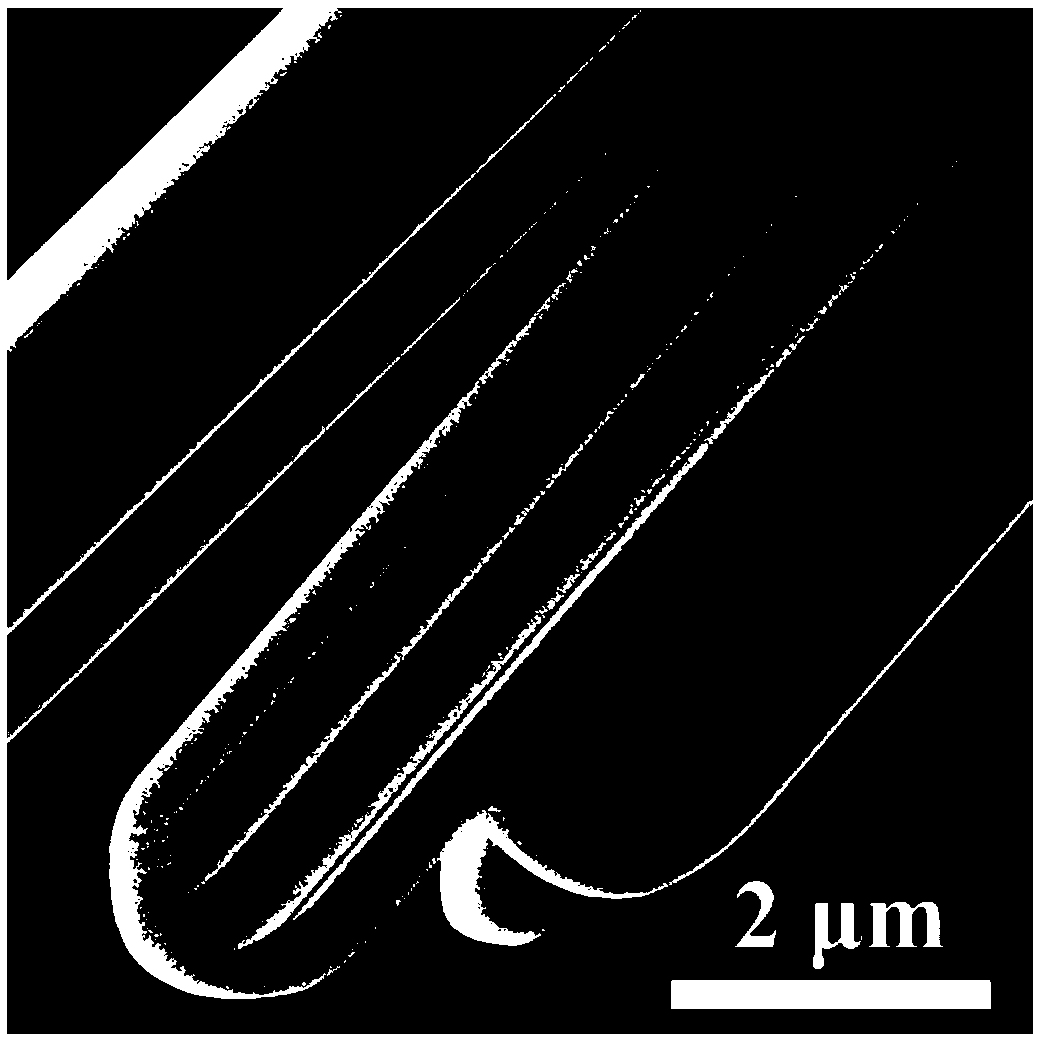Method for synthesizing groove-shaped MoO3 and product thereof
A synthesis method and gully technology, applied in the field of functional new material preparation, can solve problems such as difficult to grasp the technical route, and achieve the effects of controllable microstructure size, low cost, and special microscopic morphology
- Summary
- Abstract
- Description
- Claims
- Application Information
AI Technical Summary
Problems solved by technology
Method used
Image
Examples
Embodiment 1
[0025] (1) A mixed solvent of 1.0 mL ethanol, 4.0 mL DMF and 1.0 mL triethylamine was prepared, and 0.4937 g of molybdenum pentachloride (MoCl 5 ), 0.0298 g 2-methylimidazole, 0.0046 g dicyandiamide, and 0.999 g PVP were sequentially added to the above mixed solvent, and stirred to obtain a spinning solution;
[0026] (2) The spinning solution was electrospun into precursor fibers. The spinning parameters were as follows: positive voltage 17 KV, negative voltage 0.5 KV, receiving distance 18 cm, and syringe advancing speed 0.001 mm / s;
[0027] (3) The precursor fiber was calcined in a muffle furnace, and the temperature was raised from room temperature to 600 °C at a rate of 1 °C / min, and kept for 3 h. After the sample was cooled with the furnace, a ravine-shaped MoO was obtained. 3 Material;
[0028] The XRD of the product in embodiment 1 is as figure 1 It can be seen from the figure that the intensity of the diffraction peak is higher, the crystallinity of the product is b...
Embodiment 2
[0030] (1) Prepare a mixed solvent of 1.0 mL of ethanol, 4.0 mL of DMF and 1 mL of triethylamine, and mix 0.3292 g of MoCl 5 , 0.0149 g 2-methylimidazole, 0.0025 g dicyandiamide, and 0.5994 g PVP were sequentially added to the above-mentioned mixed solvent, and stirred to obtain a spinning solution;
[0031] (2) The spinning solution was electrospun into precursor fibers, and the spinning parameters were: positive voltage 16 KV, negative voltage 0.5 KV, receiving distance 17 cm, and syringe advancing speed 0.001 mm / s;
[0032] (3) The precursor fiber was calcined in a muffle furnace, and the temperature was raised from room temperature to 550 °C at a rate of 1 °C / min, and kept for 2 h. After the sample was cooled with the furnace, a gully-shaped MoO was obtained. 3 material, with a diameter of 0.8-1.8 μm, a groove width of 40-120 nm, and a groove depth of 20-70 nm.
Embodiment 3
[0034] (1) Prepare a mixed solvent of 1.0 mL ethanol, 4.0 mL DMF and 1.0 mL triethylamine, and mix 0.6583 g of MoCl 5 , 0.0498 g 2-methylimidazole, 0.0071 g dicyandiamide, and 1.4652 g PVP were sequentially added to the above-mentioned mixed solvent, and stirred to obtain a spinning solution;
[0035] (2) The spinning solution was electrospun into precursor fibers. The spinning parameters were as follows: positive voltage 18 KV, negative voltage 0.5 KV, receiving distance 19 cm, and syringe advancing speed 0.002 mm / s;
[0036] (3) The precursor fiber was calcined in a muffle furnace, and the temperature was raised from room temperature to 650 °C at a rate of 1 °C / min, and kept for 4 h. After the sample was cooled with the furnace, a ravine-shaped MoO was obtained. 3 material with a diameter of 1.5-3.5 μm, a groove width of 80-220 nm, and a groove depth of 40-120 nm.
PUM
| Property | Measurement | Unit |
|---|---|---|
| diameter | aaaaa | aaaaa |
| width | aaaaa | aaaaa |
| depth | aaaaa | aaaaa |
Abstract
Description
Claims
Application Information
 Login to View More
Login to View More - R&D
- Intellectual Property
- Life Sciences
- Materials
- Tech Scout
- Unparalleled Data Quality
- Higher Quality Content
- 60% Fewer Hallucinations
Browse by: Latest US Patents, China's latest patents, Technical Efficacy Thesaurus, Application Domain, Technology Topic, Popular Technical Reports.
© 2025 PatSnap. All rights reserved.Legal|Privacy policy|Modern Slavery Act Transparency Statement|Sitemap|About US| Contact US: help@patsnap.com


